
The Majestic Cetina River Canyon
Discover the breathtaking beauty and thrilling adventures of the Cetina River Canyon in Croatia, where nature and history come together in perfect harmony.
Nestled in the heart of Croatia, the Cetina River Canyon is a natural wonder that captivates visitors with its stunning landscapes and thrilling adventures. Stretching over 105 kilometers, the river carves through rugged cliffs and lush greenery, creating a breathtaking tapestry of nature's beauty. Whether you're an adrenaline junkie or a nature lover, the Cetina River Canyon offers something for everyone. One of the most popular activities in the canyon is white-water rafting. The Cetina River's rapids vary in intensity, making it an exciting experience for both beginners and seasoned rafters. As you navigate the crystal-clear waters, you'll be treated to panoramic views of the surrounding cliffs and forests, making it an unforgettable adventure. For those who prefer a more relaxed pace, the canyon also offers opportunities for hiking, swimming, and picnicking. The trails along the canyon lead to various vantage points where you can take in the serene beauty of the river and its surroundings. The cool, refreshing waters of the Cetina River are perfect for a swim on a hot day, while the shaded areas along the banks provide ideal spots for a peaceful picnic. In addition to its natural beauty, the Cetina River Canyon is rich in history and culture. The town of Omiš, located at the mouth of the river, was once a stronghold of pirates. Today, it offers a glimpse into Croatia's past with its historic buildings and charming streets. Don't miss the chance to explore the town's medieval fortresses and sample local delicacies at one of its many restaurants. Whether you're seeking adventure, relaxation, or a bit of both, the Cetina River Canyon is a must-visit destination that promises to leave you in awe of Croatia's natural and cultural treasures.
Local tips in Cetina River Canyon
- Visit between May and September for the best weather and conditions for outdoor activities.
- Wear comfortable hiking shoes if you plan to explore the trails.
- Book your rafting tour in advance, especially during peak season.
- Bring a waterproof camera to capture the stunning scenery while rafting.
- Explore the town of Omiš for a taste of local history and cuisine.
The Majestic Cetina River Canyon
Nestled in the heart of Croatia, the Cetina River Canyon is a natural wonder that captivates visitors with its stunning landscapes and thrilling adventures. Stretching over 105 kilometers, the river carves through rugged cliffs and lush greenery, creating a breathtaking tapestry of nature's beauty. Whether you're an adrenaline junkie or a nature lover, the Cetina River Canyon offers something for everyone. One of the most popular activities in the canyon is white-water rafting. The Cetina River's rapids vary in intensity, making it an exciting experience for both beginners and seasoned rafters. As you navigate the crystal-clear waters, you'll be treated to panoramic views of the surrounding cliffs and forests, making it an unforgettable adventure. For those who prefer a more relaxed pace, the canyon also offers opportunities for hiking, swimming, and picnicking. The trails along the canyon lead to various vantage points where you can take in the serene beauty of the river and its surroundings. The cool, refreshing waters of the Cetina River are perfect for a swim on a hot day, while the shaded areas along the banks provide ideal spots for a peaceful picnic. In addition to its natural beauty, the Cetina River Canyon is rich in history and culture. The town of Omiš, located at the mouth of the river, was once a stronghold of pirates. Today, it offers a glimpse into Croatia's past with its historic buildings and charming streets. Don't miss the chance to explore the town's medieval fortresses and sample local delicacies at one of its many restaurants. Whether you're seeking adventure, relaxation, or a bit of both, the Cetina River Canyon is a must-visit destination that promises to leave you in awe of Croatia's natural and cultural treasures.
When is the best time to go to Cetina River Canyon?
Iconic landmarks you can’t miss
Zipline Croatia
Experience the thrill of a lifetime at Zipline Croatia in Omiš, where adventure meets breathtaking views and unforgettable memories.

Rafting Pirate Omis
Embark on an exhilarating rafting adventure in Omiš, Croatia, with Rafting Pirate, where stunning landscapes and thrilling experiences await.
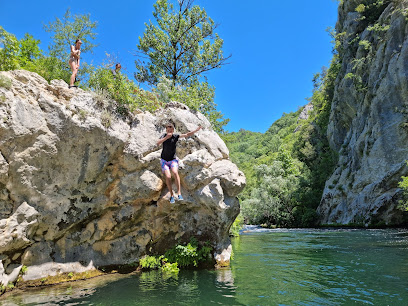
Croatia Rafting
Experience the thrill of white-water rafting in Omiš, Croatia, surrounded by stunning landscapes and breathtaking natural beauty.
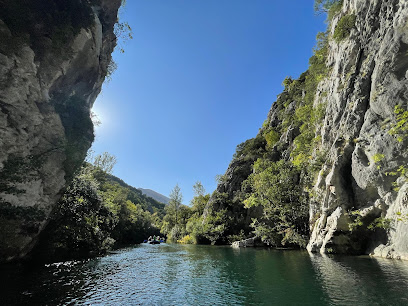
Mila Gojsalić
Discover the captivating Mila Gojsalić monument in Gata, where history meets the breathtaking beauty of the Cetina Canyon.

Cetina Bridge
Experience the stunning beauty and rich history at the breathtaking Cetina Bridge in Omiš, Croatia.

Robinson Rafting Croatia - Magic World Adventure
Discover the thrill of rafting and adventure sports in the breathtaking Cetina River Canyon at Robinson Rafting Croatia.

Lookout - Cetina Gorge
Discover the stunning beauty of Cetina Gorge at the lookout point, where breathtaking views and nature's splendor await every visitor.

Izvor Vuković (manji izvor rijeke Cetine)
Explore the serene beauty of Izvor Vuković, a picturesque spring of the Cetina River, perfect for nature lovers and peaceful retreats.

Eye of Kroatien
Explore the stunning Eye of Kroatien, a breathtaking natural wonder in Cetina, Croatia, surrounded by lush landscapes and rich folklore.

River Cetina Bridge
Discover the breathtaking beauty of River Cetina Bridge in Blato na Cetini, a picturesque spot perfect for nature lovers and photography enthusiasts.

Studenci Cetina
Experience the serene beauty of Studenci Cetina in Kostanje, a tranquil tourist attraction perfect for nature lovers and adventure seekers alike.

River Cetina
Explore the scenic River Cetina in Omiš, a Croatian paradise for adventure seekers and nature lovers with stunning views and thrilling activities.

Cetina river shore
Explore the tranquil beauty of the Cetina River Shore, a must-visit destination for nature lovers and adventure seekers in Croatia.

Alte Cetina Brücke
Explore the Alte Cetina Brücke, a historical gem in Croatia offering stunning views, rich heritage, and a serene escape into nature's embrace.
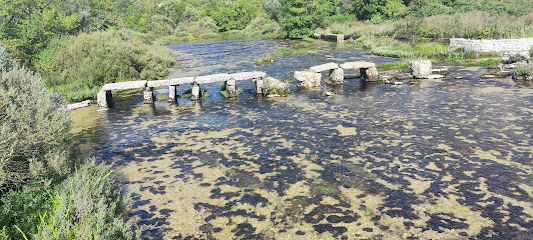
Unmissable attractions to see
Zipline Croatia
Discover the adrenaline-pumping adventure of Zipline Croatia, soaring above the stunning Cetina River canyon in Omiš.

Tvrđava Fortica (Starigrad)
Discover the breathtaking views and rich history at Tvrđava Fortica, an iconic fortress overlooking Starigrad's stunning Adriatic coastline.

Kudin most na Krupi
Explore the stunning natural beauty of Kudin Most na Krupi, a captivating waterfall and canyon in Golubić, Croatia, perfect for adventure and relaxation.

Flarent
Explore the beauty and history of Split with Flarent, your trusted tour agency for unforgettable experiences and adventures.

Mila Gojsalić
Discover the breathtaking views and rich history at Mila Gojsalić, a monument celebrating Croatia's cultural heritage amidst stunning landscapes.

Dominican monastery
Discover the historic Dominican Monastery in Bol, a serene retreat with stunning architecture and breathtaking Adriatic views on the beautiful island of Brač.

Plaža Milna
Explore the tranquil shores of Plaža Milna, a stunning public beach in Croatia perfect for relaxation, swimming, and soaking up the sun.

Plaža Kaštelet
Discover the serene beauty of Plaža Kaštele, a public beach in Split, Croatia, perfect for relaxation, sunbathing, and water sports.
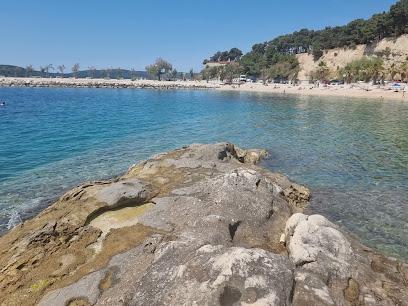
Split Sea Tours
Explore the stunning Adriatic Sea with Split Sea Tours, offering unforgettable boat adventures and rentals in the heart of Split, Croatia.

Adventure Omis | Canyoning Kayaking Rafting Biking Climbing
Discover the thrill of canyoning, kayaking, rafting, and biking in Omiš, Croatia, at Adventure Omis, your ultimate adventure sports center.

Rafting Experience Cetina
Experience the thrill of rafting on the stunning Cetina River in Split, Croatia, surrounded by breathtaking natural beauty and adventure.

Split by Tuk Tuk - City Tour
Experience the vibrant charm of Split on a Tuk Tuk city tour, blending fun, culture, and breathtaking views of Croatia's stunning coastal city.

Buk Omis
Experience the thrill of rafting in crystal-clear waters at Buk Omis, surrounded by breathtaking landscapes in Slime, Croatia.
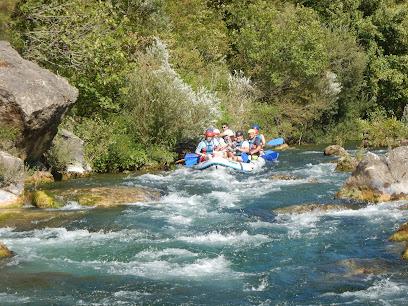
Beach Mala Milna
Discover the breathtaking beauty of Beach Mala Milna, a tranquil public beach in Milna, Croatia, perfect for relaxation and water activities.

Gecko Tours
Explore the stunning landscapes and rich culture of Split with Gecko Tours, your gateway to unforgettable adventures in Croatia.

Essential places to dine
Pizzeria ANTULA
Discover authentic Italian flavors at Pizzeria ANTULA in Omiš - where every slice tells a story!

Radmanove mlinice
Discover culinary delights at Radmanove Mlinice along the serene Cetina River; a perfect blend of nature and traditional Croatian flavors.

River Cetina
Explore the stunning landscapes of River Cetina – a haven for adventure seekers and nature lovers alike in Croatia's picturesque Dalmatia region.

Konoba Bracera
Savor the taste of Croatia at Konoba Bracera - where tradition meets flavor in every dish.

Restoran PULJIZ
Experience authentic Croatian cuisine at Restoran PULJIZ in Omiš – where every dish tells a story of tradition and flavor.

LOCAL Bar & Kitchen
Discover LOCAL Bar & Kitchen in Omiš: A top destination for pizza lovers and cocktail enthusiasts alike.

Beach & lounge bar Fortica
Experience relaxation and vibrant atmosphere at Beach & Lounge Bar Fortica in Omiš – your ultimate coastal escape.

Cocopazzo wine and dine bar
Discover exquisite flavors at Cocopazzo Wine and Dine Bar in Omiš—where local ingredients meet exceptional wines in a stunning setting.

Restoran Kaštil Slanica
Experience authentic Dalmatian cuisine at Restoran Kaštil Slanica with breathtaking views along the scenic Cetina River.

Konoba Kremenko
Discover authentic Croatian cuisine at Konoba Kremenko in Svinišće – where tradition meets flavor in a cozy setting.

Rafting Pirate Omis
Experience thrilling rafting adventures on the stunning Cetina River with Rafting Pirate Omiš - an unforgettable outdoor journey awaits!

Konoba Bajso
Experience authentic Croatian cuisine at Konoba Bajso in Jesenice, where fresh ingredients meet traditional recipes for a memorable dining adventure.

Restaurant Dalmacija
Experience authentic Dalmatian cuisine at Restaurant Dalmacija with stunning sea views and a warm atmosphere perfect for every occasion.
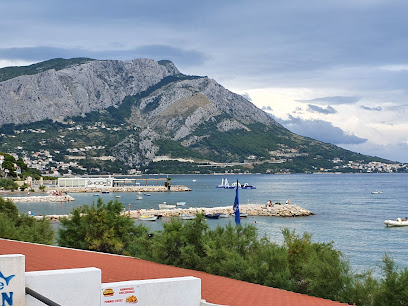
Gusarska Konoba
Discover the flavors of Croatia at Gusarska Konoba in Omiš - where tradition meets taste in every dish.

Konoba Tadici
Experience authentic Croatian cuisine with stunning views at Konoba Tadici in Slime - perfect for families and food lovers alike.

Markets, malls and hidden boutiques
Zipline Croatia
Zipline Croatia: An exhilarating adventure soaring above the stunning Cetina River canyon, perfect for thrill-seekers and nature lovers alike.

Rafting Pirate Omis
Experience thrilling white-water rafting on the stunning Cetina River with Rafting Pirate Omis, a must-visit for adventure seekers in Croatia.

Vir Rafting Cetina
Unleash your adventurous spirit with thrilling rafting experiences on the picturesque Cetina River in Croatia.

Rafting Cetina
Explore the thrill of rafting on the stunning Cetina River in Omiš, where adventure meets breathtaking natural beauty.
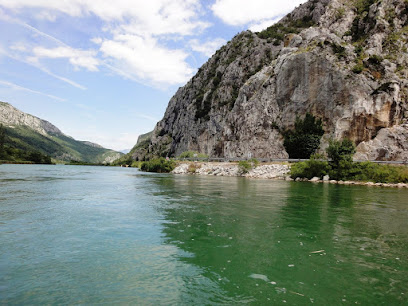
Cetina River Canyon
Discover the breathtaking beauty and adventure of Cetina River Canyon in Croatia, where stunning landscapes meet thrilling outdoor experiences.

Origin - Croatian cosmetics
Discover authentic Croatian cosmetics and unique souvenirs at Origin, a charming store in Omiš showcasing local craftsmanship and natural beauty.

Dalmatia Getaway
Experience the thrill of adventure sports in the stunning landscapes of Omiš, Croatia, at Dalmatia Getaway.

Studenci Cetina
Discover the enchanting beauty of Studenci Cetina, a premier destination for adventure seekers and nature lovers in Croatia's Kostanje region.

Suvenirnica Cetina
Explore Suvenirnica Cetina for unique, locally crafted souvenirs that embody the spirit of Croatia, perfect for gifts and mementos.
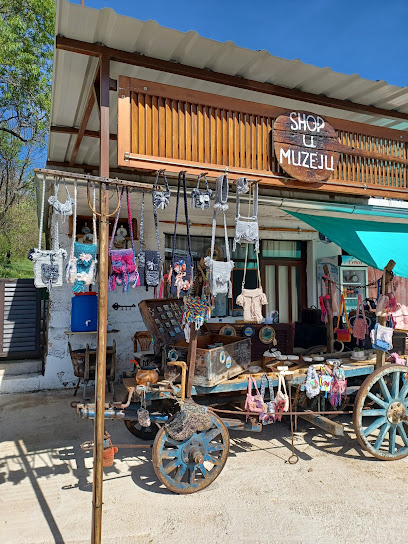
River Cetina
Experience the breathtaking beauty and thrilling adventures at River Cetina, a stunning natural gem near Omiš, Croatia.

Essential bars & hidden hideouts
Radmanove mlinice
Experience the flavors of Croatia at Radmanove Mlinice, a charming riverside restaurant offering traditional dishes and stunning views of the River Cetina.

Beach & lounge bar Fortica
Discover beachfront bliss at Beach & Lounge Bar Fortica, where relaxation meets vibrant coastal culture in Omiš, Croatia.
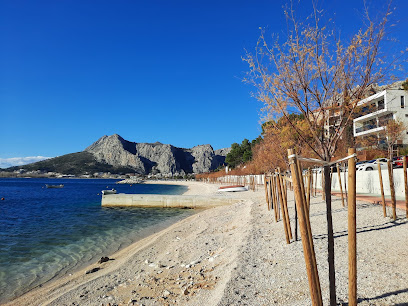
OSKAR Nemira
Discover the charm of OSKAR Nemira, a cozy cafe and cocktail bar in Omiš, perfect for relaxation and enjoying breathtaking coastal views.
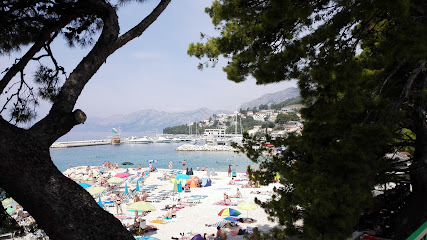
Cb Prestige
Discover the vibrant atmosphere of Cb Prestige, a charming bar in Omiš with scenic views of the Cetina River, perfect for relaxation and socializing.
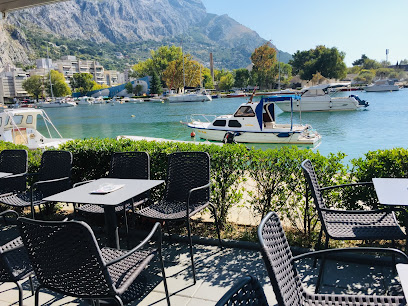
Eol Bar
Discover the enchanting Eol Bar in Omiš, where stunning views meet a vibrant atmosphere for an unforgettable experience.

Local Phrases about Cetina River Canyon
-
- HelloBok
[Bohk] - GoodbyeDoviđenja
[Dov-ee-jen-ya] - YesDa
[Dah] - NoNe
[Neh] - Please/You're welcomeMolim
[Moh-leem] - Thank youHvala
[Hvah-lah] - Excuse me/SorryOprostite
[O-proh-stee-teh] - How are you?Kako si?
[Kah-koh see] - Fine. And you?Dobro. A ti?
[Doh-bro. Ah tee] - Do you speak English?Govoriš li engleski?
[Go-vo-ree-sh lee eng-les-kee] - I don't understandNe razumijem
[Neh rah-zoo-mee-yem]
- HelloBok
-
- I'd like to see the menu, pleaseMolio bih meni, molim
[Moh-lee-oh bee meh-nee, moh-leem] - I don't eat meatNe jedem meso
[Neh yeh-dem meh-so] - Cheers!Živjeli!
[Zhee-ve-lee] - I would like to pay, pleaseŽelim platiti, molim
[Zheh-leem plah-tee-tee, moh-leem]
- I'd like to see the menu, pleaseMolio bih meni, molim
-
- Help!Pomoć!
[Poh-mohtch] - Go away!Otiđi!
[O-tee-jee] - Call the Police!Nazovite policiju!
[Nah-zoh-vee-teh poh-lee-tsee-yoo] - Call a doctor!Pozovite doktora!
[Poh-zoh-vee-teh dohk-toh-rah] - I'm lostIzgubio/la sam se
[Eez-goo-byoh/lah sahm seh] - I'm illBolestan/na sam
[Boh-leh-stahn/nah sahm]
- Help!Pomoć!
-
- I'd like to buy...Želio bih kupiti...
[Zheh-lee-yo bee koo-pee-tee] - I'm just lookingSamo gledam
[Sah-moh gleh-dam] - How much is it?Koliko košta?
[Koh-lee-koh kohs-tah] - That's too expensiveTo je preveliko
[Toh yeh preh-veh-lee-koh] - Can you lower the price?Možete li spustiti cijenu?
[Moh-zheh-teh lee spoos-tee-tee tsee-yeh-noo]
- I'd like to buy...Želio bih kupiti...
-
- What time is it?Koliko je sati?
[Koh-lee-koh yeh sah-tee] - It's one o'clockJedan je sat
[Yeh-dahn yeh saht] - Half past (10)Pola (deset)
[Poh-lah (deh-set)] - MorningJutro
[Yoo-troh] - AfternoonPopodne
[Poh-pohd-neh] - EveningVečer
[Veh-chehr] - YesterdayJučer
[Yoo-cher] - TodayDanas
[Dah-nahs] - TomorrowSutra
[Soo-trah] - 1Jedan
[Yeh-dahn] - 2Dva
[Dvah] - 3Tri
[Tree] - 4Četiri
[Cheh-tee-ree] - 5Pet
[Peh-t] - 6Šest
[Shehst] - 7Sedam
[Seh-dahm] - 8Osam
[Oh-sahm] - 9Devet
[Deh-vet] - 10Deset
[Deh-set]
- What time is it?Koliko je sati?
-
- Where's a/the...?Gdje je...?
[Gdyeh yeh] - What's the address?Koja je adresa?
[Koyah yeh ah-dreh-sah] - Can you show me (on the map)?Možete li mi pokazati (na karti)?
[Moh-zheh-teh lee mee poh-kah-zah-tee (nah kar-tee)] - When's the next (bus)?Kada je sljedeći (autobus)?
[Kah-dah yeh sl-yeh-deh-chee (ow-toh-boos)] - A ticket (to ....)Jednu kartu (do...)
[Yeh-dnoo kahr-too (doh)]
- Where's a/the...?Gdje je...?
History of Cetina River Canyon
-
The Cetina River Canyon has been home to human settlements since the ancient Illyrian tribes inhabited the region. The Illyrians were known for their fortifications and hillforts, many of which were strategically placed along the canyon to control the trade routes and defend against invaders. Archaeological evidence of these early settlers, including artifacts and remnants of their fortresses, can still be found in the area.
-
In the 1st century BC, the Roman Empire extended its reach into the Cetina River Canyon, incorporating it into the province of Dalmatia. The Romans recognized the strategic importance of the canyon and established several settlements and infrastructure projects, including roads and bridges to facilitate movement and trade. The remains of these Roman structures, such as the ancient roadways and the ruins of the town of Tilurium, offer a glimpse into the Roman way of life in the region.
-
During the medieval period, the Cetina River Canyon was a contested region, with various powers vying for control. Notable fortresses such as the Klis Fortress and the Sinj Fortress were built to defend against invasions and to control the strategic passages through the canyon. The Battle of Sinj in 1715 is a significant event, where the local defenders successfully repelled the Ottoman forces, a victory celebrated annually with the Alka tournament in Sinj.
-
The Ottoman Empire's influence in the Cetina River Canyon began in the 15th century, leaving a lasting impact on the region's culture and architecture. The Ottomans introduced new agricultural practices, crafts, and architectural styles. Some of the notable Ottoman contributions include the construction of bridges and the establishment of trade routes that revitalized the local economy. The legacy of this period can still be seen in the cultural fusion present in the region's customs and traditions.
-
Following the decline of the Ottoman Empire, the Cetina River Canyon came under the control of the Austro-Hungarian Empire in the late 19th century. This period saw significant modernization efforts, including the development of infrastructure such as railways and roads, which improved connectivity and boosted the local economy. The Austro-Hungarian influence is evident in the architectural styles of buildings and the introduction of new administrative and social structures.
-
During World War II, the Cetina River Canyon was a hotspot for partisan resistance against Axis forces. The rugged terrain of the canyon provided a natural refuge for the Yugoslav Partisans, who conducted guerrilla warfare and played a crucial role in the liberation efforts. The bravery and resilience of the partisans are commemorated through various monuments and memorials scattered throughout the region, reminding visitors of this turbulent yet heroic chapter in the canyon's history.
-
In the post-war period, the Cetina River Canyon has seen a revival of its cultural heritage and natural beauty. Efforts to preserve the historical sites and promote tourism have transformed the canyon into a popular destination for history enthusiasts and nature lovers alike. Festivals, traditional music, and culinary events celebrate the rich cultural tapestry of the region, ensuring that the legacy of the Cetina River Canyon continues to thrive in modern times.
Cetina River Canyon Essentials
-
The Cetina River Canyon is located in the Dalmatian region of Croatia, near the town of Omiš. The nearest international airport is Split Airport, approximately 40 kilometers away. From the airport, you can take a taxi, bus, or arrange for a car rental to reach Omiš. The journey typically takes around 45 minutes by road. Alternatively, you can reach Omiš by bus from other major Croatian cities such as Split, Dubrovnik, and Zagreb, with regular services operated by various bus companies.
-
Within the Cetina River Canyon area, the most common modes of transportation are cars and bicycles. Renting a car can be a convenient option for exploring the canyon and its surrounding areas at your own pace. For a more eco-friendly option, bicycles are available for rent in Omiš. Local taxis are also available for shorter trips. Public buses operate between Omiš and nearby towns, but schedules can be infrequent, so it's advisable to check timings in advance.
-
The official currency in Croatia is the Croatian Kuna (HRK). Credit cards are widely accepted in hotels, restaurants, and larger shops, but it is advisable to carry some cash, especially when visiting smaller establishments or rural areas. ATMs are available in Omiš and other major towns, making it easy to withdraw cash as needed. Currency exchange services are also available at banks and exchange offices.
-
The Cetina River Canyon is generally a safe destination for tourists. However, it is always wise to take standard precautions. Avoid leaving your belongings unattended and be cautious in crowded areas. The town of Omiš and the surrounding canyon are considered safe, with low crime rates targeting tourists. Nevertheless, it is advisable to remain vigilant and aware of your surroundings at all times.
-
In case of an emergency, dial 112 for immediate assistance. This number connects you to emergency services, including police, medical, and fire departments. The nearest medical facilities are located in Omiš, with more comprehensive services available in Split. It is recommended to have travel insurance that covers medical emergencies. Pharmacies in Omiš can provide over-the-counter medications for minor health issues.
-
Fashion: Do wear comfortable and practical clothing suitable for outdoor activities. Avoid overly revealing clothing when visiting religious sites. Religion: Do respect local customs and traditions. Public Transport: Do be respectful and offer your seat to elderly passengers. Don't eat or drink on public transport. Greetings: Do greet people with a smile and a polite 'Dobar dan' (Good day). A handshake is also common. Eating & Drinking: Do try local delicacies such as 'peka' and 'soparnik'. Don't refuse food or drink offerings, as it is considered impolite.
-
To experience the Cetina River Canyon like a local, consider exploring the area by kayak or raft, which offers a unique perspective of the canyon's stunning landscapes. Visit the local market in Omiš to purchase fresh produce and traditional Croatian goods. Engage with locals, who are often friendly and eager to share their knowledge about the region's history and culture. Don't miss the opportunity to hike to the Starigrad Fortress for breathtaking views of the canyon and the Adriatic Sea.
Trending Landmarks in Cetina River Canyon
Nearby Cities to Cetina River Canyon
-
Things To Do in Makarska
-
Things To Do in Hvar
-
Things To Do in Trogir
-
Things To Do in Mostar
-
Things To Do in Jajce
-
Things To Do in Zenica
-
Things To Do in Zadar
-
Things To Do in Dubrovnik
-
Things To Do in Sarajevo
-
Things To Do in Banja Luka
-
Things To Do in Trebinje
-
Things To Do in Bihac
-
Things To Do in Herceg Novi
-
Things To Do in Perast
-
Things To Do in Nikšić









